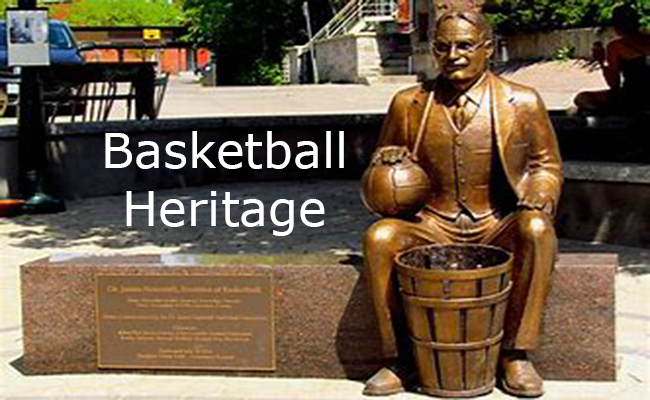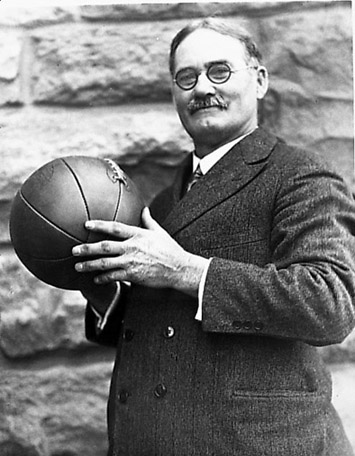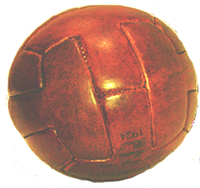- Offensive Techniques & Strategies
Original Basketball Rules

The Game of Basketball - A Product of a Well Thought Out Process
The game of basketball is often referred to as the only major sport which originated in the United States. However, the game was actually created by Dr. James Naismith, a Canadian born of Scottish ancestry, way back in December 1891 when he nailed peach baskets to the balconies at each end of the International Young Men's Christian Association Training School (now Springfield College in Springfield, Massachusetts). Unlike many other popular sports, basketball was not conceived by changing the principles or rules of an existing game. It was a deliberate and original invention created out of necessity to provide a challenging, vigorous activity that could be played indoors.

Naismith was given the task of creating a safe, easy to learn indoor game for his physical education class primarily comprised of rugby and football (soccer) players. After unsuccessfully attempting to modify existing games, Naismith set out to create an entirely new game.
His main criteria being that the game must be simple and easy to learn. In analyzing existing team sports, he came up with three generalizations:
1. Team games use balls.
2. Running with the ball entails physical contact.
3. That team games all have goals.1. The BALL

Balls were, basically, of two types: small and large. However, small balls required some type of equipment associated with them. Baseball and cricket had bats, lacrosse and hockey had sticks, and tennis and squash had rackets. In addition to safety issues, the use of implements makes a game more difficult and harder to learn. Since large balls are easier to handle and require little practice to catch and throw, Naismith decided that a large ball would be best. Two balls were available to him: Rugby and Football (Soccer). Because of its round shape, he settled on using a soccer ball.
2. PLAYER SAFETY
Rugby was the most popular team game at the time. However, since players could run with the ball, it required tackling. Naismith reason that by not allowing running with the ball, it would eliminate the physical contact and roughness of the game. Since players could not run with the ball, players would be allowed to throw the ball in any direction. He, also, made allowance for moving receivers to take an extra step upon receiving the ball in order to stop.
3. GOAL
Existing team games all have some type of objective or goal. Rugby had goal lines, Soccer, Lacrosse and Hockey had nets, Tennis & Badminton had out of bounds lines. Without a goal, the new game would simply amount to “Keep Away” with players quickly losing interest. Therefore, some type of a goal was necessary.
Naismith reasoned in using vertical goals, such as soccer, lacrosse and hockey nets, it would lead to unnecessary roughness problems since the harder the ball is thrown at the goal, the more chance of its success. Therefore, in using a horizonal goal, it would eliminate the need to use excessive force since the ball would have to be thrown into the goal using an arc. He decided to use boxes located at each end of the floor as goals. Successfully throwing the ball into the box would count as a goal. The goals would have to be placed above the players' heads and reach in order to eliminate the defenders from just standing around the goal making it impossible to score.
PEACH BASKETS
Since boxes were not readily available at the time, two peach baskets were used instead. They were nailed to the gym's balcony. The height turned out to be ten feet. A height that is still in use today. Once the format of the game was established, Naismith compiled a list of thirteen rules. He attached the list on a bulletin board and the game of basketball was born.

The first game was played with a soccer ball, nine player teams, and governed by a set of thirteen rules. The team size was actually determined by the total number of students (18) in Naismith's physical education class. Although there was no scorebook, the score of the first game was said to be 1-0 with William Chase credited in making the first basket in the history of basketball. It was reported to be approximately 25' (a half court shot in the small Springfield gymnasium) midway through the 30 minute game.

These original rules were first published in January 1892 in the school's newspaper, The Triangle. All of these original rules are in some way still in effect today (see comments).
1. The ball may be thrown in any direction with one or both hands.
Comment: Still current today. The ball can be passed or thrown in any direction with the exception that once the ball crosses the midcourt line, it cannot be passed back behind the midcourt line.
2. The ball may be batted in any direction with one or both hands (never with the fist.)
Comment: Ball can still be batted or tipped in any direction with one or both hands but never with a closed fist. Ball also cannot be kicked.
3. A player cannot run with the ball. The player must throw it from the spot on which he catches it, allowance to be made for a man who catches the ball when running at a good speed if he tries to stop.
Comment: A player still cannot run with the ball. If they do it’s a violation. They must pass or dribble the ball with one hand. No allowance made when receiving a pass.
4. The ball must be held in or between the hands; the arms or body must not be used for holding it.
Comment: Players still cannot hold the ball against their body when moving. Results in a traveling violation.
5. No shouldering, holding, pushing, tripping, or striking in any way the person of an opponent shall be allowed; the first infringement of this rule by any player shall count as a foul, the second shall disqualify him until the next goal is made, or, if there was evident intent to injure the person, for the whole of the game, no substitute allowed.
Comment: These infractions or player fouls still apply. Players are disqualified from the game after committing five or six fouls. Flagrant fouls may result in automatic ejections along with suspensions.
6. A foul is striking at the ball with the fist, violation of Rules 3, 4, and such as described in Rule 5.
Comment: True today. The ball cannot be struck with a closed fist or kicked.
7. If either side makes three consecutive fouls, it shall count a goal for the opponents (consecutive means without the opponents in the mean time making a foul.
Comment: This rule has been replaced by bonus free throws after a certain number of team fouls.
8. A goal shall be made when the ball is thrown or batted from the grounds into the basket and stays there, providing those defending the goal do not touch or disturb the goal. If the ball rests on the edges, and the opponent moves the basket, it shall count as a goal.
Comment: Ball now goes through the basket. Defensive basket interference and offensive goal tending rules still apply. However, FIBA rules allow touching the ball by either team once it hits the rim.
9. When the ball goes out of bounds, it shall be thrown into the field of play by the person first touching it. In case of a dispute, the umpire shall throw it straight into the field. The thrower-in is allowed five seconds; if he holds it longer, it shall go to the opponent. If any side persists in delaying the game, the umpire shall call a foul on that side.
Comment: This out of bounds rule has been changed in that ball possession goes to the opposite team of the last player touching the ball. The inbounds five second count is still in effect and shot clocks have replaced the delay of game fouls.
10. The umpire shall be judge of the men and shall note the fouls and notify the referee when three consecutive fouls have been made. He shall have power to disqualify men according to Rule 5.
Comment: The umpire has been replaced with two or three person officiating crews. Player disqualifications have been modified to five or six personal fouls.
11. The referee shall be judge of the ball and shall decide when the ball is in play, in bounds, to which side it belongs, and shall keep the time. He shall decide when a goal has been made, and keep account of the goals with any other duties that are usually performed by a referee.
Comment: The referee has essentially been replaced by official scorers and timers. Out of bounds and goal decisions are made by the on court officials.
12. The time shall be two 15-minute halves, with five minutes’ rest between.
Comment: Game formats including length and the number of periods played along with halftime periods vary according to level.
13. The side making the most goals in that time shall be declared the winner. In case of a draw, the game may, by agreement of the captains, be continued until another goal is made.
Comment: Sudden death or the first team to score has been replaced with five minute overtime periods.
From these original rules, the game has evolved into an exciting, high scoring, spectator sport played by the world's greatest athletes.
Take a look at the evolution of these original rules into today's game - Click Here
Return to Basketball Basics' Main Menu - Click Here
© 2026 HoopTactics All Rights Reserved.
